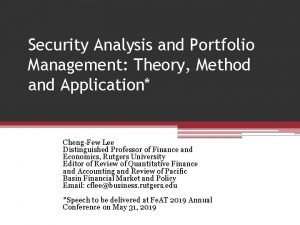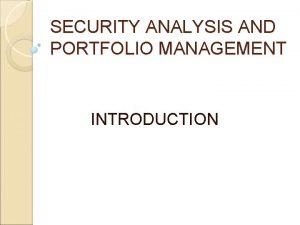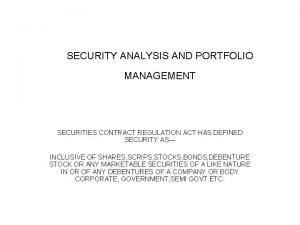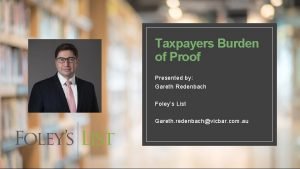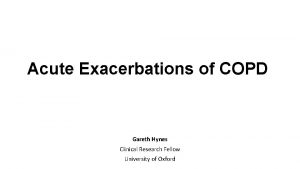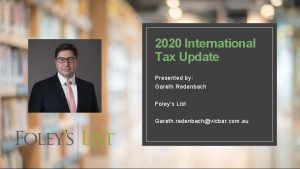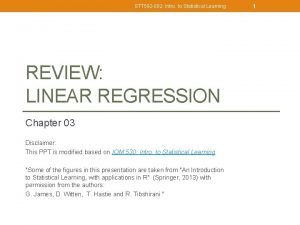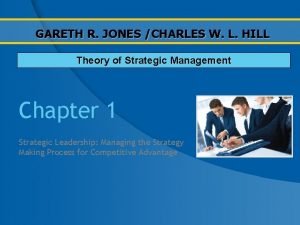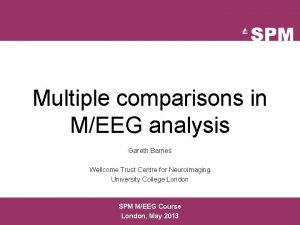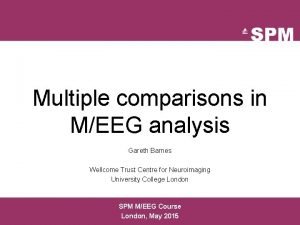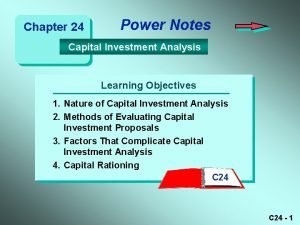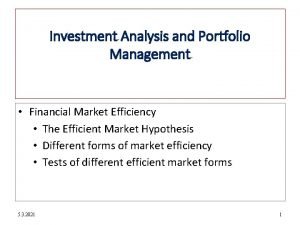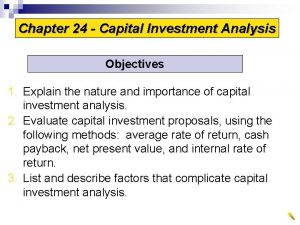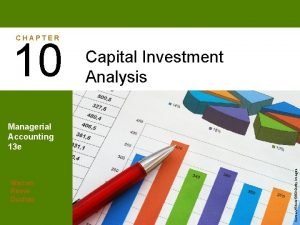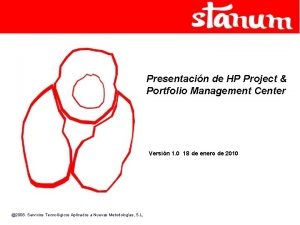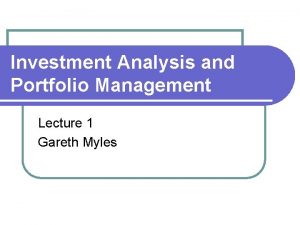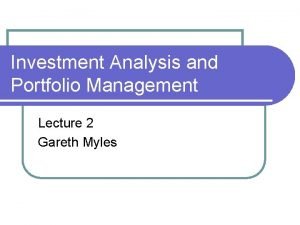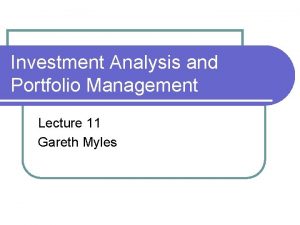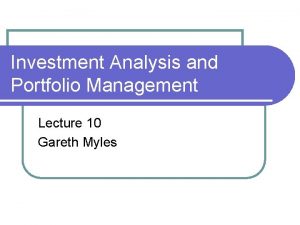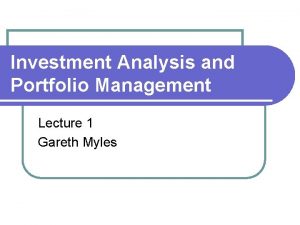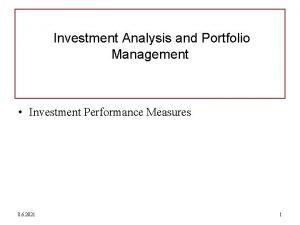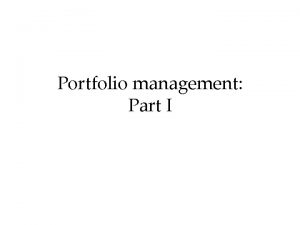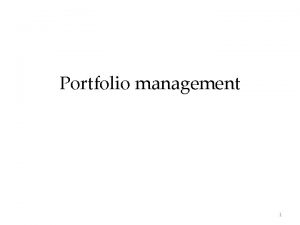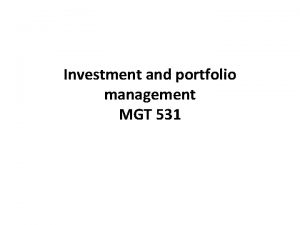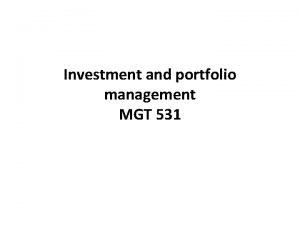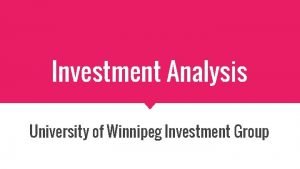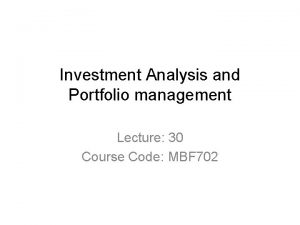Investment Analysis and Portfolio Management Lecture 3 Gareth










































![Effect of Diversification N terms in the first summation, N[ N-1] in the second Effect of Diversification N terms in the first summation, N[ N-1] in the second](https://slidetodoc.com/presentation_image_h2/178eb0db52eb87363e54977272b7cb1c/image-43.jpg)

- Slides: 44

Investment Analysis and Portfolio Management Lecture 3 Gareth Myles

FT 100 Index

£ and $

Risk l Variance The standard measure of risk is the variance of return or l Its square root: the standard deviation l l Sample l variance The value obtained from past data l Population l variance The value from the true model of the data

Sample Variance General Motors Stock Price 1962 -2008

Sample Variance Year Return % 93 -94 94 -95 36. 0 -9. 2 98 -99 99 -00 -1. 2 25. 3 95 -96 96 -97 97 -98 17. 6 7. 2 34. 1 00 -01 01 -02 02 -03 -16. 6 12. 7 -40. 9 Return on General Motors Stock 1993 -2003

Sample Variance Graph of return

Sample Variance l With T observations sample variance is l The standard deviation is Both these are biased estimators l The unbiased estimators are l

Sample Variance l l For the returns on the General Motors stock, the mean return is 6. 5 Using this value, the deviations from the mean and their squares are given by Year 93 -94 29. 5 870. 25 98 -99 94 -95 -15. 7 246. 49 99 -00 95 -96 11. 1 123. 21 00 -01 96 -97 0. 49 01 -02 97 -98 27. 6 761. 76 02 -03 -7. 7 59. 29 18. 8 353. 44 -23. 1 533. 61 6. 2 38. 44 -47. 4 2246. 76

Sample Variance l l After summing and averaging, the variance is The standard deviation is This information can be used to compare different securities l A security has a mean return and a variance of the return l

Sample Covariance l The covariance measures the way the returns on two assets vary relative to each other l l l Positive: the returns on the assets tend to rise and fall together Negative: the returns tend to change in opposite directions Covariance has important consequences for portfolios Asset A B Return in 2001 10 2 Return in 2002 2 10

Sample Covariance Mean return on each stock = 6 l Variances of the returns are l Portfolio: 1/2 of asset A and 1/2 of asset B l l Return in 2001: l Return in 2002: l Variance of return on portfolio is 0

Sample Covariance l The covariance of the return is l It is always true that l ii.

Sample Covariance l Example. The table provides the returns on three assets over three years Year 1 Year 2 Year 3 l A B 10 10 12 14 11 12 C 12 6 9 Mean returns

Sample Covariance l Covariance between A and B is l Covariance between A and C is

Variance-Covariance Matrix l Covariance between B and C is l The matrix is symmetric

Variance-Covariance Matrix l For the example the variance-covariance matrix is

Population Return and Variance Expectations: assign probabilities to outcomes l Rolling a dice: any integer between 1 and 6 with probability 1/6 l Outcomes and probabilities are: {1, 1/6}, {2, 1/6}, {3, 1/6}, {4, 1/6}, {5, 1/6}, {6, 1/6} l Expected value: average outcome if experiment repeated l

Population Return and Variance Formally: M possible outcomes l Outcome j is a value xj with probability pj l Expected value of the random variable X is l l The sample mean is the best estimate of the expected value

Population Return and Variance l After market analysis of Esso an analyst determines possible returns in 2010 Return Probability l 2 6 9 12 0. 3 0. 2 The expected return on Esso stock using this data is E[r. Esso] =. 2(2) +. 3(6) +. 3(9) +. 2(12) = 7. 3

Population Return and Variance The expectation can be applied to functions of X l For the dice example applied to X 2 l l And to X 3

Population Return and Variance l The expected value of the square of the deviation from the mean is l This is the population variance

Modelling Returns l States of the world l l Provide a summary of the information about future return on an asset A way of modelling the randomness in asset returns l Not intended as a practical description

Modelling Returns Let there be M states of the world l Return on an asset in state j is rj l Probability of state j occurring is pj l Expected return on asset i is l

Modelling Returns Example: The temperature next year may be hot, warm or cold l The return on stock in a food production company in each state l State Return l Hot 10 Warm Cold 12 18 If each states occurs with probability 1/3, the expected return on the stock is

Portfolio Expected Return l l l N assets M states of the world Return on asset i in state j is rij Probability of state j occurring is pj Xi proportion of the portfolio in asset i Return on the portfolio in state j

Portfolio Expected Return l The expected return on the portfolio l Using returns on individual assets l Collecting terms this is l So

Portfolio Expected Return Example: Portfolio of asset A (20%), asset B (80%) l Returns in the 5 possible states and probabilities are: l State Probability Return on A 1 0. 1 2 2 0. 2 6 3 0. 4 9 Return on B 5 1 0 4 5 0. 1 0. 2 1 2 4 3

Portfolio Expected Return l For the two assets the expected returns are l For the portfolio the expected return is

Population Variance and Covariance l Population variance The sample variance is an estimate of this l Population covariance l l The sample covariance is an estimate of this

Population Variance and Covariance M states of the world, return in state j is rij l Probability of state j is pj l Population variance is l l Population standard deviation is

Population Variance and Covariance l Example: The table details returns in five possible states and the probabilities State Return Probability l 1 5 2 2 3 -1 4 6 5 3 0. 1 0. 2 0. 4 0. 1 0. 2 The population variance is

Portfolio Variance l l l Two assets A and B Proportions XA and XB Return on the portfolio r. P Mean return Portfolio variance

Portfolio Variance l Population covariance between A and B is l For M states with probabilities pj

Portfolio Variance l The portfolio return is l So l Collecting terms

Portfolio Variance l Squaring l Separate the expectations l Hence

Portfolio Variance l Example: Portfolio consisting of l l 1/3 asset A 2/3 asset B l The variances/covariance are l The portfolio variance is

Correlation Coefficient l The correlation coefficient is defined by l Value satisfies l perfect positive correlation r. B r. A

Correlation Coefficient l perfect negative correlation r. B r. A l Variance of the return of a portfolio

Correlation Coefficient l Example: Portfolio consisting of l l 1/4 asset A 3/4 asset B l The variances/correlation are l The portfolio variance is

General Formula N assets, proportions Xi l Portfolio variance is l l But so

Effect of Diversification: a means of reducing risk l Consider holding N assets l Proportions Xi = 1/N l Variance of portfolio l
![Effect of Diversification N terms in the first summation N N1 in the second Effect of Diversification N terms in the first summation, N[ N-1] in the second](https://slidetodoc.com/presentation_image_h2/178eb0db52eb87363e54977272b7cb1c/image-43.jpg)
Effect of Diversification N terms in the first summation, N[ N-1] in the second l Gives l l Define l Then

Effect of Diversification Let N tend to infinity (extreme diversification) l Then l l Hence l In a well-diversified portfolio only the covariance between assets counts for portfolio variance
 Investment analysis and portfolio management notes
Investment analysis and portfolio management notes Scope of investment analysis and portfolio management
Scope of investment analysis and portfolio management Investment analysis and portfolio management course
Investment analysis and portfolio management course Investment analysis & portfolio management
Investment analysis & portfolio management Fixed investment and inventory investment
Fixed investment and inventory investment 01:640:244 lecture notes - lecture 15: plat, idah, farad
01:640:244 lecture notes - lecture 15: plat, idah, farad Security analysis and portfolio management project
Security analysis and portfolio management project Security analysis and portfolio management project
Security analysis and portfolio management project Importance of security analysis and portfolio management
Importance of security analysis and portfolio management Risk in security analysis and portfolio management
Risk in security analysis and portfolio management Example of portfolio in science
Example of portfolio in science Gareth redenbach
Gareth redenbach Gareth mead
Gareth mead Wellbeing plate
Wellbeing plate Gareth hynes
Gareth hynes Gareth price duke
Gareth price duke Plinkling
Plinkling Criminology unit 3 notes
Criminology unit 3 notes Gareth denyer
Gareth denyer Gareth johns
Gareth johns Gareth jones
Gareth jones Foogle transle
Foogle transle Dr gareth james
Dr gareth james The crocodile by gareth lancaster
The crocodile by gareth lancaster Gareth philips
Gareth philips Dr gareth hughes
Dr gareth hughes Gareth james pools
Gareth james pools Gareth redenbach
Gareth redenbach Gareth phillips afdb
Gareth phillips afdb Faculty marshall usc advertising csv
Faculty marshall usc advertising csv Charles w. l. hill y gareth jones
Charles w. l. hill y gareth jones Hashesorg
Hashesorg Psir 426
Psir 426 Gareth barnes
Gareth barnes Gareth barnes
Gareth barnes Gareth roy
Gareth roy Gareth wyn davies
Gareth wyn davies Project planning and management lecture notes ppt
Project planning and management lecture notes ppt Financial investment analysis
Financial investment analysis Factors that complicate capital investment analysis
Factors that complicate capital investment analysis Financial investment analysis
Financial investment analysis Factors that complicate capital investment analysis
Factors that complicate capital investment analysis Factors that complicate capital investment analysis
Factors that complicate capital investment analysis Factors that complicate capital investment analysis
Factors that complicate capital investment analysis Hp project management
Hp project management






